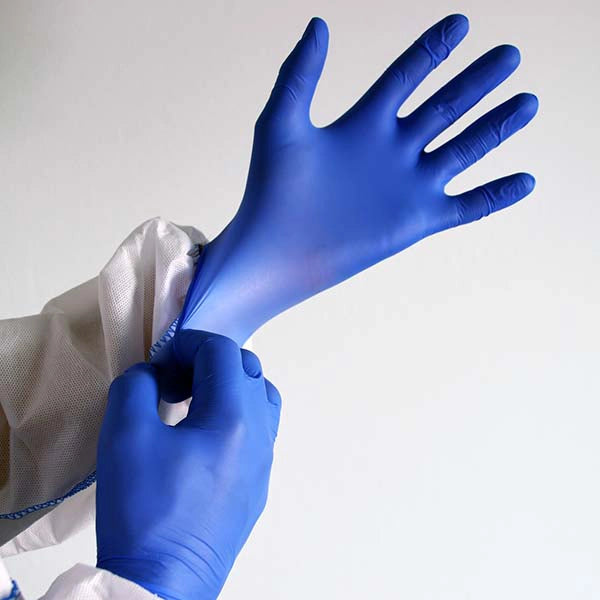When it comes to protecting yourself and your patients in a medical setting, choosing the right gloves is paramount. Medical gloves serve as a barrier against the spread of germs, illnesses, and infections, ensuring the safety of both the wearer and the patient.
With various types of medical gloves available, such as examination gloves, surgical gloves, and chemotherapy gloves, it's essential to understand their specific uses and benefits to make an informed decision.
In this article, we'll dive into the world of medical gloves, exploring their types, uses, and how to select the best ones for your needs.
What are Medical Gloves?
Medical gloves are personal protective equipment designed to protect both the wearer and the patient from the spread of germs, illness, and infection. They create a barrier between the healthcare provider's hands and the patient, minimizing the risk of cross-contamination and transmission of harmful microorganisms.
Medical gloves come in different categories, including examination gloves, surgical gloves, and chemotherapy gloves. Each type serves a specific purpose and offers varying levels of protection based on the materials used and the intended application.
Examples of Medical Glove Uses
Medical gloves find applications in a wide range of healthcare settings and procedures. Some common examples include:
- Routine examinations: During physical exams, healthcare providers wear medical gloves to protect themselves and the patient from the exchange of bodily fluids and potential infections. Gloves are essential for tasks such as taking vital signs, conducting physical assessments, and performing minor procedures.
- Surgical procedures: Surgical gloves are specifically designed for use in operating rooms and other sterile environments. They provide a higher level of protection and precision compared to standard examination gloves. Surgeons and assisting staff wear surgical gloves to maintain a sterile field and prevent the introduction of contaminants into the surgical site.
- Handling chemotherapy agents: Chemotherapy gloves are specialized gloves that offer enhanced protection against the hazardous chemicals used in cancer treatment. These gloves are thicker and more resistant to penetration, ensuring the safety of healthcare workers who handle and administer chemotherapy drugs.
Types of Medical Gloves
Latex Gloves
Latex gloves, made from natural rubber, provide superior elasticity and comfort for the wearer. They offer the highest level of protection against viruses and bacteria, making them a popular choice in healthcare settings. However, it's important to note that latex gloves may trigger allergic reactions in some users.
Nitrile Gloves
Nitrile gloves, a synthetic rubber alternative, are an excellent choice for those with latex allergies. These gloves offer superior puncture and chemical resistance, making them suitable for a wide range of medical procedures. Nitrile gloves are known for their durability and long shelf life, ensuring reliable protection.
Vinyl Gloves
Vinyl gloves, made from synthetic materials, are another latex-free option. While they are less elastic and durable compared to latex or nitrile gloves, they are suitable for low-risk and short-duration tasks. Vinyl gloves are a cost-effective choice for situations where frequent glove changes are necessary.
Chloroprene Gloves
Chloroprene gloves, made from synthetic rubber, offer properties similar to latex gloves. They provide comfort and durability without the presence of latex proteins, reducing the risk of allergic reactions. Chloroprene gloves are more expensive than latex but less costly than nitrile, making them a balanced choice for medical professionals.
5 Best Gloves for Medical Use
1. HandCare Latex Powder-Free Gloves (Multipurpose)
Features:
- Made from high-quality latex, these gloves provide superior elasticity and comfort.
- Powder-free design eliminates the risk of powder-related skin irritation or allergic reactions, making them suitable for individuals with sensitive skin.
- Multipurpose use allows for versatility in various medical and non-medical settings, from patient care to lab work.
Why It’s Great: These gloves offer a high level of dexterity, making them ideal for detailed medical procedures, while the powder-free aspect ensures that healthcare professionals can use them for extended periods without discomfort or irritation. The large box size is perfect for high-turnover environments like hospitals or clinics.
2. Polysilk by Shamrock Black Latex Gloves - Exam Grade, Powder-Free (4 Mil)
Features:
- With a 4-mil thickness, these gloves strike the perfect balance between durability and dexterity, making them ideal for both delicate tasks and more rugged procedures.
- The powder-free design ensures that there is no risk of contamination or irritation during use, making them perfect for clinical and exam settings.
- The black color adds an extra level of sophistication and makes it easier to spot any contaminant that may compromise the sterile field.
Why It’s Great: These gloves are perfect for medical professionals who require a reliable glove for detailed procedures. The textured fingertips offer better grip, making these gloves ideal for handling medical instruments or other tools where precision is required.
3. HandCare Black Nitrile Gloves - Exam Grade, Powder-Free (4 Mil)
Features:
- These nitrile gloves are latex-free, making them safe for individuals with latex allergies. Nitrile is known for its superior puncture resistance compared to latex or vinyl.
- At 4 mils thick, these gloves provide excellent tactile sensitivity without sacrificing durability, making them ideal for exams or procedures where precision and protection are equally important.
- Powder-free for safer use in sterile or sensitive environments, preventing any risk of powder contamination.
Shop HandCare Black Nitrile Gloves and save up to 50% now
Why It’s Great: HandCare’s black nitrile gloves are great for high-risk environments where strong protection is necessary. Their resistance to chemicals and tears makes them particularly suited for emergency care, lab work, or any medical setting requiring high durability without losing tactile dexterity.
4. ASAP Orange Nitrile Gloves - Exam Grade, Powder-Free (5 Mil)
Features:
- These gloves are made from high-visibility orange nitrile, which enhances safety in environments where clear identification is crucial.
- The 5-mil thickness ensures extra protection against punctures and tears, while still maintaining enough flexibility to allow for easy hand movement.
- Latex-free and powder-free, these gloves are designed for users with latex sensitivities and are safe for both healthcare workers and patients.
Shop ASAP Orange Nitrile Gloves and save up to 50% now
Why It’s Great: The bright orange color not only ensures better visibility but also enhances safety by allowing quick identification of glove integrity in high-risk environments like surgery rooms or labs. The 5-mil thickness provides a balance between durability and comfort, making them suitable for a wide variety of medical tasks.
5. HandCare Vinyl Gloves - Exam Grade, Powder-Free (Clear)
Features:
- Vinyl is a synthetic material that is both latex- and powder-free, making these gloves safe for individuals with latex allergies or sensitivities.
- These gloves are less elastic than latex or nitrile but provide a comfortable, loose fit that is ideal for low-risk, routine tasks such as patient examinations or non-invasive procedures.
- Easy to put on and remove, these gloves are perfect for environments where quick changes are needed, such as outpatient clinics or home healthcare settings.
Shop HandCare Vinyl Gloves and save up to 50% now
Why It’s Great: HandCare’s vinyl gloves offer an affordable and reliable solution for medical professionals who need a cost-effective, disposable glove option for low-risk tasks. Their powder-free design ensures that they are suitable for sensitive skin and safe for patients.
Factors to Consider When Choosing Medical Gloves
When selecting the best gloves for medical use, several factors come into play. These include the level of protection required, the specific task at hand, and the user's individual needs and preferences.
Protection Level
Consider the level of protection needed based on the medical procedure or task. For high-risk situations involving exposure to bodily fluids or infectious materials, gloves with superior barrier properties, such as latex or nitrile, are recommended. For lower-risk tasks, vinyl gloves may suffice.
Fit and Comfort
Proper glove fit ensures both comfort and effectiveness. Gloves that are too loose can compromise dexterity and increase the risk of contamination, while gloves that are too tight can cause discomfort and hand fatigue. Select gloves that provide a snug fit while allowing for easy movement and tactile sensitivity.
Allergies and Sensitivities
If you or your patients have known latex allergies or sensitivities, opt for latex-free alternatives like nitrile or vinyl gloves. These materials provide similar levels of protection without the risk of triggering allergic reactions.
Durability and Puncture Resistance
For tasks that involve handling sharp objects or exposure to chemicals, choose gloves with high durability and puncture resistance , such as nitrile gloves. These gloves offer enhanced protection against tears and punctures, reducing the risk of exposure to hazardous materials.
Benefits of Using the Right Medical Gloves
Wearing the appropriate medical gloves offers several advantages that contribute to your safety and the well-being of your patients. Let's explore the key benefits of using the right medical gloves in your practice.
Enhanced Protection
Medical gloves act as a barrier, shielding you from exposure to bodily fluids, chemicals, and harmful substances encountered during medical procedures. They minimize the risk of cross-contamination and transmission of infectious agents, ensuring a safer working environment for both you and your patients.
Improved Comfort
Selecting medical gloves that fit properly and are made from suitable materials can significantly enhance your comfort during extended periods of use. Well-fitted gloves reduce hand fatigue and minimize the occurrence of skin irritation, allowing you to focus on delivering quality patient care without discomfort.
Increased Dexterity
Medical gloves are designed to provide optimal tactile sensitivity, enabling you to perform precise procedures with confidence. Gloves with a snug fit and textured fingertips offer improved grip and dexterity, allowing you to handle instruments and manipulate tissues with greater ease and accuracy.
Meets Safety Standards
Medical gloves are regulated by governing bodies to ensure they meet stringent quality and safety requirements. When you choose medical-grade gloves, you can trust that they have undergone rigorous testing and adhere to industry standards, providing reliable protection and performance.
Industrial gloves , while suitable for certain applications, may not meet the same level of quality and safety standards as medical-grade gloves. It's important to select gloves specifically designed and certified for medical use to ensure optimal protection and compliance with healthcare regulations.
How to Choose the Best Medical Gloves
When selecting medical gloves, it's important to consider the material that best suits your needs. Latex gloves offer excellent protection and flexibility but may trigger allergies in some individuals. Nitrile gloves, made from synthetic rubber, provide similar protection without the risk of latex allergies. Vinyl gloves are a cost-effective option for low-risk tasks, while chloroprene gloves combine the benefits of latex and nitrile.
Evaluate the level of protection required based on your potential exposure to chemicals, bodily fluids, or infectious agents. Gloves with higher thickness and durability are recommended for high-risk situations, while thinner gloves may suffice for routine examinations.
Proper glove fit is key to ensuring both comfort and effectiveness. Measure your hand circumference at the widest point and the length from the tip of your middle finger to the base of your palm. Use these measurements to select the appropriate glove size. Well-fitted gloves should be snug but not restrictive, allowing for easy movement and tactile sensitivity.
Sterile vs. non-sterile gloves is another important consideration. Sterile gloves are required for invasive procedures and surgeries to maintain a sterile field and prevent infection. Non-sterile gloves are suitable for most routine patient care tasks and examinations.
Comfort and dexterity are also factors to keep in mind when choosing medical gloves. Glove thickness, texture, and elasticity can impact your ability to perform tasks efficiently. Thinner gloves may provide better tactile sensitivity for delicate procedures, while textured gloves can enhance grip. Gloves with good elasticity allow for a comfortable fit and reduce hand fatigue during extended use.
Tips for Comfortable Medical Glove Use
Choosing the right size is crucial for comfortable glove use. Measure your hand circumference and length to find the perfect fit. A snug fit prevents slippage and excess material that can hinder dexterity.
If you have specific needs, such as sweaty hands or eczema , select gloves designed to address those concerns. Gloves with moisture-wicking properties or hypoallergenic materials can provide added comfort and protection.
Change your gloves regularly, especially if they become torn, punctured, or heavily soiled. Wearing damaged or contaminated gloves compromises their protective abilities and increases the risk of exposure.
Practice proper glove removal technique to minimize the risk of contamination. Avoid touching your skin with the outside of the glove when removing them. Grasp the cuff of one glove and peel it off, turning it inside out as you remove it. Use the inside-out glove to grasp and remove the second glove, again turning it inside out. Dispose of the gloves properly and wash your hands thoroughly afterward.
Where to Buy the Best Gloves for Medical Use
Choosing the right medical gloves ensures safety, comfort, and efficiency in healthcare settings. gloves.com offers a wide range of high-quality gloves to meet your specific needs and protect you effectively.






